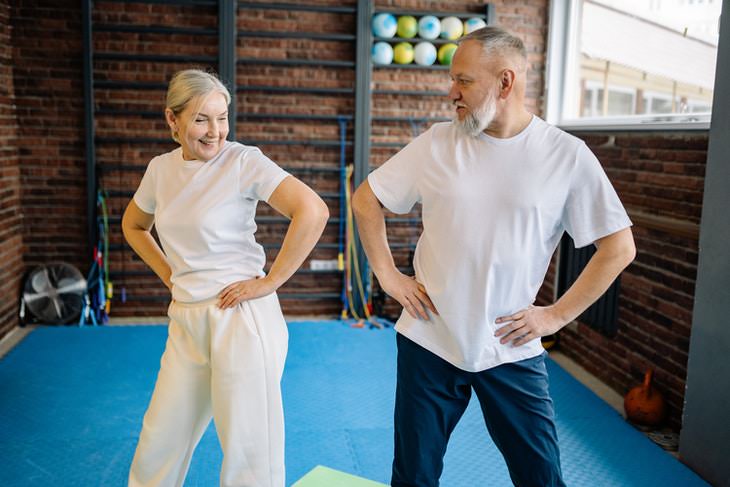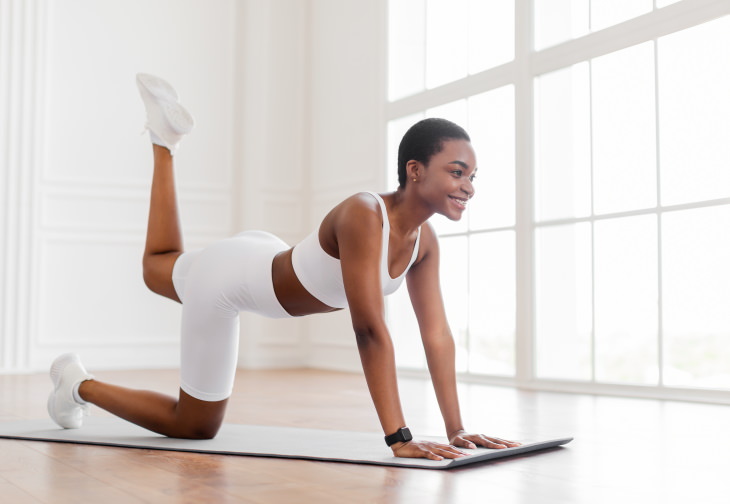

Let’s begin by pointing out that weak and stiff hips are an extremely common issue in younger and older adults alike. Excessive sitting and a general lack of movement are believed to be the biggest culprits. After all, the hip is one of the most mobile joints in the entire human body that rotates along 3 different planes: forward or backward, internally or externally, and to the sides.
When you deprive the hips of movement, some of the muscles and connective tissues can become tight, and the resulting imbalance may cause pain. Certain health conditions, such as arthritis or previous injuries, can also contribute to hip pain. In fact, nearly 15% of adults 60 and older report significant and persistent hip pain.
If decreased hip mobility is your chief concern, consider looking through this article - Stretches That Help Maintain Your Hips.
But hip mobility isn’t the only function of the hip joints. They also play a massive role in maintaining balance while standing, walking, and getting up from a seated position. Weakened hip muscles can make everyday activities like walking, squatting, bending, and using the stairs challenging. Therefore, strengthening the hips can make a tremendous change in the daily life of seniors.
Last but definitely not least, remember that the benefits of hip exercise also improve the alignment of the knees and lower back, so these types of exercises are also beneficial for folks suffering from pain in the knees and lower back, including arthritic pain and joint stiffness.

Anyone can start practicing the hip-strengthening exercises we list below at home. In case you experience difficulty stating or have problems with balance, begin with the exercises that can be performed in a chair or in a reclined position. Over time, your hip strength will increase, and you’ll be able to try the standing exercises we list in this article as well. Beginners will also benefit from completing the standing exercises near a wall, railing, table, or any other stable surface. You can hold on to it for added support.
The three main groups of muscles we target in the exercises below are:
- The gluteus maximus is the large muscle located at the surface of the backside. It helps extend the hip and rotate it externally.
- The gluteus medius is a fan-shaped muscle in the back of the hip that abducts the thigh and helps rotate it internally.
- Hip flexor muscles. This is a group of muscles that consists of the iliacus, the psoas, and the rectus femoris muscles that connect the lower back and the thigh. These muscles are activated when you take a step or get up from a chair.
This is one of the best exercises for building strength in the hips and thighs.
More specifically, it targets the hip flexor muscles that play a big role in lifting the legs. When these muscles are shorter than they should be, this can shorten your steps, slow you down, and lead to foot-dragging, all of which increases the risk of trips or falls.
Here’s how to complete this exercise:
1. Sit in a chair with your feet flat on the floor.
2. Lift one leg with the knee bent as high as possible.
3. Hold for one second and lower the foot back to the floor.
4. Repeat the same steps on the other side.
Perform 5-10 repetitions on each side. Complete 2-3 sets.
Like the previous exercise, hip circles promote stability and mobility in the hips. If you need extra support, hold onto a table or any other stable surface for support. Once you practice and increase hip strength, you can try and complete larger circles.
Here’s how to complete this exercise:
1. Stand up straight near a table (chair, wall, or any other stable surface) and hold onto it for stability. Lift one leg.
2. Start moving the lifted leg in small circles. Complete around 10-20 circles clockwise and then move in the other direction.
3. Return to the initial position. Repeat the same steps on the other side.
You can do up to 2-3 sets of this exercise.

The donkey kicks exercise is beneficial for supporting the muscles in the hips and glutes. It activates the gluteus maximus muscles, and it’s also beneficial for your core muscles.
Here’s how to complete this exercise:
1. Start on all fours. Lift one knee as high as you can. You can keep the knee bent or straight, whatever feels more comfortable for you.
2. Lower the leg to the initial position.
3. Complete the same steps on the other side. This is one repetition.
Perform 10-20 repetitions. Complete 2-3 sets.
This hip exercise trains the gluteus medius muscles. When completing the exercise, you will feel a stretch in the hamstrings and the front of the groin - this is normal.
Here’s how to complete this exercise:
1. Stand near a table (chair, wall, or any other stable surface) and hold onto it for stability.
2. Keep both legs straight, then extend the left leg to the side. Make sure to stand straight (do not hunch the back) and hold this position for 1 second.
3. Return to the initial position and repeat on the other leg.
Perform 10 repetitions on each side. Complete 3 sets.
Related Article: 3 Simple Exercises to Combat Knee & Hip Pain

The benefit of the bridge exercise is that it strengthens the glutes and can easily be done in a reclined position. The glutes play a huge role in hip extension, so it’s great for promoting balance too.
Here’s how to complete this exercise:
1. Lie down on the back. Bend the knees and keep the feet flat.
2. Activate the glute muscles and slowly lift the hips. Resist from arching the back and activate the abs to protect the lower back.
3. Hold the position for 3 seconds. If this is tough on your lower back, you can support your back with your hands.
4. Gently return to the initial position. This is one repetition.
Perform 5-10 repetitions. Complete 2-3 sets.
Find it difficult to get out of a chair? The best way to feel more confident about it is to practice doing so. Note that practicing the sit-to-stand action will also strengthen the glute muscles, so you will also notice a difference in your sense of balance and distance between steps if you practice this simple skill over time.
Here’s how to complete this exercise:
1. Sit in a chair. Slightly lean forward and activate your legs when you rise from the chair. Resist from using your hands when you’re getting up.
2. When you reach the upright position, really squeeze the glute muscles to extend the hips completely.
3. Hold this position for 1 second, and then use the muscle strength in your hips to guide yourself back into the seated position.
Perform 10 repetitions. Complete up to 3 sets of this exercise.
Share these exercises with family and friends!
H/T: Very Well Health, Healthline